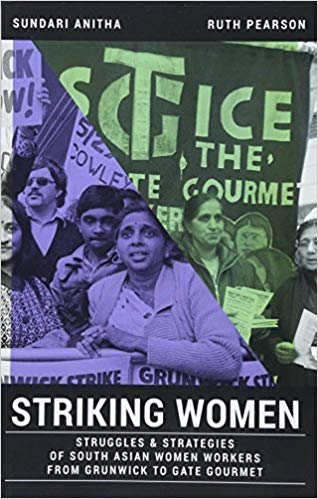Striking Women is a well-researched reexamination of two strikes in the United Kingdom (UK) that saw the mobilization of migrant South Asian women workers against highly exploitative and racially structured low-paying jobs, which have been overcrowded by a predominantly female labour force. One of these strikes, the Grunwick strike of 1976-77, is well-documented and is, in fact, eulogized by the British trade union movement as a struggle that marked the ‘successful’ incorporation of the issues of ‘black’ and women workers within the British labour movement. The second strike is that of workers employed by the airline catering enterprise, Gate Gourmet. This strike of 2005 and the resulting lengthy industrial dispute is far less documented by the labour movement, largely due to the schism that soon emerged between the strikers and their union on the question of a ‘settlement’ offered by the management. The authors, Sundari Anitha and Ruth Pearson, identify their endeavour as the recounting of the workers’ story and not the union’s story. The book is hence based on a close examination of the lived experience of the women workers who struck work, with the authors consciously adopting a methodology that is far from event-specific. Going beyond the strikers’ memories of the specific incident and modalities of the strike, Anitha and Pearson also focus on the broader history of who the strikers were, and these women’s larger work/life histories. Migration histories of these women, their evolving family and community structures, and the gendered inequalities within migrant families as well in workplaces are emphasized as the authors work with detailed information captured in extensive semi-structured interviews in Hindi. The purpose of such methodology, the authors claim, is to better understand the triggers for strike action against increasingly oppressive managerial controls, and to expose the intersecting dynamics of the situation these migrant workers faced as women employed in low paying jobs and juggling familial responsibilities in changing work regimes. The authors explore at length the worker’s story, i.e., the motivation for resistance which went beyond just the frictions on the production line, the experiences of workers before and during the prolonged dispute, as well as the repercussions of the said events on the strikers’ political and social identities. Overall, it is the intersection of the workers’ class, ethnic and gendered identities as well as migration experiences that is emphasized by the authors when comprehending the workers’ resistance. The authors’ intersectionality framework of analysis is, thus, a crucial aspect of their methodology and assessment.

Lived Experiences
Maya John
Striking Women: Struggles And Strategies Of South Asian Women Workers From Grunwick To Gate Gourmet by Sundari Anitha and Ruth Pearson Lawrence and Wishart, London, 2018, 232 pp., £18.00
September 2018, volume 42, No 9
